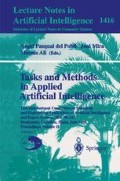Abstract
The role of perception and action in current AI systems is analyzed and some points concerning present AI methodologies are discussed. It is argued that if we accept as a central goal for AI to build artificial systems that behave in an intelligent way in the real world, then additional evaluation criteria for intelligent systems should be used. Finally, some of these criteria are proposed.
Preview
Unable to display preview. Download preview PDF.
References
Brady, M. (1985), “Artificial Intelligence and Robotics”, Artificial Intelligence 26, 79–121, 1985.
Brooks, R.A. (1990) “Elephants Don't Play Chess”, Robotics and Autonomous Systems, 6, 3–15.
Brooks, R.A. (1991) “Intelligence without Representation”, Artificial Intelligence 47, 139–159.
Cervera, E., del Pobil, A.P. (1997) “Programming and Learning in Real-World Manipulation Tasks”, in Proc. IEEEIRSJ International Conference on Intelligent Robots and Systems (IROS'97), Grenoble, France.
Cervera, E., del Pobil, A.P. (1998) “Eliminating sensor ambiguities via recurrent neural networks in sensor-based learning”, in Proc. IEEE International Conference on Robotics and Automation, Leuven, Belgium.
Charniak, E., McDermott, D. (1985) Introduction to Artificial Intelligence, Addison-Wesley.
del Pobil, A.P., Serna, M.A. (1995), Spatial Representation and Motion Planning, Lecture Notes in Computer Science Vol. 1014, Springer, Berlin.
Freksa, C. (1991) “Qualitative Spatial Reasoning”, in Proc. IMACS Inter. Symposium on Decision Support Systems & Qualitative Reasoning, Toulouse, France.
Gupta, K.K., del Pobil, A.P. (eds.) (1998) Practical Motion Planning in Robotics, John Wiley & Sons, Chichester, UK.
Harnad, S. (1989) “Minds, Machines and Searle”, Journal of Theoretical and Experimental Artificial Intelligence 1: 5–25.
Harnad, S. (1990) “The Symbol Grounding Problem”, Physica D 42: 335–346.
Harnad, S. (1991) “Other bodies, Other minds: A machine incarnation of an old philosophical problem”. Minds and Machines 1: 43–54.
Harnad, S. (1992) “The Turing Test is not a Trick: Turing Indistinguishability is a Scientific Criterion”, ACM SIGART Bulletin 3(54) 9–10.
Harnad, S. (1993) “Grounding Symbolic Capacity in Robotic Capacity”, in L. Steels, R.A. Brooks (eds.) The Artificial Life route to Artificial Intelligence, Lawrence Erlbaum.
Heikkonen, J. (1994) Subsymbolic Representations, Self-Organizing Maps and Object Motion Learning, Research paper No., Lappeenranta University of Technology, Finland.
Lakoff, G. (1987) Women, fire, and dangerous things: what categories reveal about mind, University of Chicago Press, Chicago.
Martin, P., del Pobil, A.P. (1994) “Application of Artificial Neural Networks to the Robot Path Planning Problem”, in Applications of Artificial Intelligence in Engineering IX edited by G. Rzevski, R.A. Adey and D.W. Russell, Computational Mechanics Publications, Boston, pp. 73–80.
McKerrow, P.J. (1991), Introduction to Robotics, Addison-Wesley, Sidney.
Met, B.W. (1990), Connectionist Robot Motion Planning, Academic Press, San Diego, California.
Mira, J., Delgado, A.E., Boticario, J.G., Dfez, F.J. (1995), Aspectos básicos de la Inteligencia Artificial, Sanz y Torres, Madrid.
Mira, J., Delgado, A.E. (1997) “Some Reflections on the Relationships Between Neuroscience and Computation”, in Biological and Artificial Computation: From Neuroscience to Technology, edited by J. Mira, R. Moreno-Díaz and J. Cabestany, Lecture Notes in Computer Science Vol. 1240, Springer, Berlin.
Musto, D., Konolige, K. (1993) “Reasoning about Perception”, Al Communications 6: 207–212.
Sanz, P.J., del Pobil, A.P., Iñesta, J.M., Recatalá, G. (1998), “Vision guided grasping of unknown objects for service robots”, in Proc. IEEE International Conference on Robotics and Automation, Leuven, Belgium.
Schumacher, E.F. (1977) A Guide for the Perplexed. (Spanish edition titled Guía para los perplejos published by Editorial Debate, Madrid, 1981).
Searle, J. R. (1980) “Minds, Brains and Programs”, Behavioral and Brain Sciences 3: 417–424.
Sloman, A. (1993) “Prospects for AI as the General Science of Intelligence”, in Proc. AISB Conf., Birmingham.
Steels, L., Brooks, R.A. (eds.) (1993) The Artificial Life route to Artificial Intelligence. Building Situated Embodied Agents. Lawrence Erlbaum.
Turing, A.M. (1950) “Computing Machinery and Intelligence”, Mind LIX, no.2236, 433–60.
Author information
Authors and Affiliations
Editor information
Rights and permissions
Copyright information
© 1998 Springer-Verlag Berlin Heidelberg
About this paper
Cite this paper
Pasqual del Pobil, A. (1998). The grand challenge is called: Robotic intelligence. In: Pasqual del Pobil, A., Mira, J., Ali, M. (eds) Tasks and Methods in Applied Artificial Intelligence. IEA/AIE 1998. Lecture Notes in Computer Science, vol 1416. Springer, Berlin, Heidelberg. https://doi.org/10.1007/3-540-64574-8_387
Download citation
DOI: https://doi.org/10.1007/3-540-64574-8_387
Published:
Publisher Name: Springer, Berlin, Heidelberg
Print ISBN: 978-3-540-64574-0
Online ISBN: 978-3-540-69350-5
eBook Packages: Springer Book Archive

